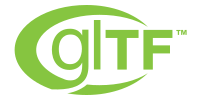glTF
 | |
| Developer(s) | Khronos Group |
|---|---|
| Initial release | 19 October 2015[1] |
| Stable release |
1.0
/ 2 June 2016[2] |
| Development status | Active |
| Platform | Cross-platform |
| Type | 3D Computer Graphics |
| Website |
Khronos |
| As of | 11 November 2016 |
glTF (GL Transmission Format) is a runtime asset delivery format for GL APIs: WebGL, OpenGL ES, and OpenGL developed by the Khronos Group 3D Formats Working Group and first announced at HTML5DevConf 2016. glTF is an efficient, interoperable asset delivery format that compresses the size of 3D scenes and models, and minimizes runtime processing by applications using WebGL and other APIs. glTF also defines a common publishing format for 3D content tools and services.
Software Ecosystem
glTF loaders are in open-source WebGL engines including Three.js, BabylonJS, Cesium, PEX, xeogl, and A-Frame. Open-source glTF converters are available from COLLADA, FBX, and OBJ. Assimp can import and export glTF. A Blender glTF exporter is in progress. Open-source glTF utility libraries are available for programming languages including JavaScript, Node.js, C++, C#, Java, Go, Rust, and Haxe. An open-source glTF validator can validate if 3D models conform to the glTF specification.
History
In March 2012, Khronos organized a meetup[3][4][5] to brainstorm about COLLADA and opportunities around WebGL traction. Fabrice Robinet volunteered to implement a proposal for an efficient JSON format with references to external binary blobs. Later, during the WebGL meetup hosted at SIGGRAPH 2012, Brandon Jones and Fabrice Robinet presented a demo of glTF, which was then called WebGL TF (WebGL Transmissions Format).[6]
In March 2013, Cesium adopted glTF[7] instead of "designing yet another asset format."
On October 19, 2015, the glTF 1.0 specification was announced.[8]
In July 2016, John Carmack said:
“The world has long needed an efficient, usable standard for 3D scenes that sits at the level of common image, audio, video, and text formats. Not an authoring format, or necessarily a format you would use for a hyper optimized platform specific application, but something at home on the internet, capable of being directly created and consumed by many different applications”[9]
At SIGGRAPH 2016, Oculus announced[10] their adoption of glTF citing the similarities to their ovrscene format.
In October 2016, Microsoft joined[11] the 3D Formats working group at Khronos to collaborate on glTF.
Notable Uses
The Santa and Reindeer model in NORAD Tracks Santa uses glTF. 3D Tiles, a proposed OGC Community Standard, builds on glTF to add a spatial data structure, metadata, and declarative styling for streaming massive heterogeneous 3D geospatial datasets.[12][13][14]
See also
References
- ↑ "Khronos Finalizes glTF 1.0 Specification - Khronos Group Press Release".
- ↑ "KhronosGroup/glTF".
- ↑ https://www.khronos.org/assets/uploads/developers/library/2012-GDC-COLLADA-WebGL-KITE-meetups/COLLADA%20Meetup%20GDC%20Mar12.pdf
- ↑ https://www.youtube.com/watch?v=xhR-vya1zRU&feature=youtu.be&t=1510
- ↑ https://www.youtube.com/watch?v=vhPGVzClUBY&feature=youtu.be&t=280
- ↑ https://www.khronos.org/webgl/wiki/Presentations#SIGGRAPH_2012_WebGL_BOF
- ↑ http://blog.virtualglobebook.com/2013/03/how-i-got-involved-in-gltf-and-khronos.html
- ↑ https://www.khronos.org/news/press/khronos-finalizes-gltf-1.0-specification
- ↑ https://www.khronos.org/news/press/significant-gltf-momentum-for-efficient-transmission-of-3d-scenes-models
- ↑ https://www.khronos.org/assets/uploads/developers/library/2016-siggraph/glTF-MobileVR-Oculus-BOF-Update-SIGGRAPH_Jul16.pdf
- ↑ https://blogs.windows.com/buildingapps/2016/10/28/bringing-3d-to-everyone-through-open-standards/#vPc4g6svcBfmMRMy.97
- ↑ "Cesium 3D Tiles".
- ↑ "OGC is considering a proposed work item for 3D Tiles as a Community Standard".
- ↑ "3D Tiles Community Standards Justification".